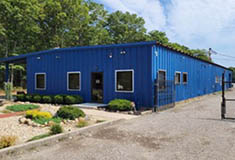News:
Long Island
Posted: June 10, 2013
100% renewable energy? 100% possible.
Can Long Island derive 100% of its electricity from renewable energy? In short: Yes.
The surprising answer comes from the Long Island Clean Electricity Vision1 — a visionary study commissioned by Renewable Energy Long Island (reLI) and member organizations of the Long Island Clean Energy Roundtable. The 2012 analysis, performed by Synapse Energy Economics, using cautious and often conservative assumptions, concludes that a clean energy transition could take place within two decades, at relatively modest cost and with significant benefits.
The major conclusions of this 100% Long Island renewables study are:
* By 2020, it appears technically feasible to meet 100% of residential electricity needs from renewables, and by 2030 to have a 100% renewable and zero-carbon electricity supply.
* Aggressive energy efficiency efforts in buildings are required to reduce wasteful consumption practices. Large amounts of wind, solar and other renewable energy sources need to be built to replace old, inefficient fossil-fueled power sources. During certain times, e.g. when not enough renewable energy is available to meet electricity demand, some existing fossil-fueled generation would be used to meet demand. Renewable Energy Credits (RECs) would be purchased to offset these emissions.
* The additional cost of switching to a 100% renewable electricity supply is modest: average customer bills are expected to increase by roughly 8-12%. The indirect costs of current practices to individuals and society (i.e. environmental and health-related costs), are not accounted for in this comparison.
Economic benefits would be significant. Much of the money LIPA now spends each year on imported fossil fuel and power ($1.5 billion in 2012) would stay on Long Island. Investing instead to make buildings energy efficient, while installing massive amounts of renewables would result in much needed construction jobs and stimulate the regional economy for the next two decades. It also offers insurance against fluctuations in fuel prices, and dramatically lowers carbon emissions and the pollution that causes health impacts.
We are not alone. The Danish island of Samsø, entirely dependent on oil and coal, began to make their homes more energy efficient, switched to biofuel heating, and installed solar panels and wind turbines. By 2005, this island of 4,300 people were using 100% renewable sources2. The city of San Francisco plans to supply 100% of its electricity needs from renewables by 2020. The Scottish government announced its aim for 100% renewable electricity for its 5 million people by 2020 with much of it coming from offshore wind farms3. A plan by Delucchi and Jacobson, featured in a 2009 Scientific American4, actually calculated how many renewable energy systems the entire world will need to meet all energy needs. They found that the cost of energy in this 100% renewable energy economy would be similar to the cost of energy today. Like many other studies, they conclude that the barriers to this global transformation "are primarily social and political, not technological or even economic." It will take determination to turn these clean energy visions into reality. Challenging the business-as-usual model will encounter opposition. "All truth passes through three stages," philosopher Arthur Schopenhauer said more than 150 years ago. "First, it is ridiculed. Second, it is violently opposed. Third, it is accepted as being self-evident."
It is evident that current energy patterns are unsustainable and harmful to our health, environment, and economy. We have the technologies to build a sustainable energy supply. What are we waiting for?
For more on the Long Island Clean Electricity Vision, see RenewableEnergyLongIsland.org/100percent.
1. www.RenewableEnergyLongIsland.org/100percent
2. See for example Kolbert, Elizabeth. "The Island in the Wind," The New Yorker, July 7, 2008. http://www.newyorker.com/reporting/2008/07/07/080707fa_fact_kolbert (Accessed March 26, 2013)
3. APS Group Scotland. 2020 Routemap for Renewable Energy in Scotland. Edinburgh, Scotland: The Scottish Government, 2011. http://www.scotland.gov.uk/Resource/Doc/917/0118802.pdf (Accessed March 26, 2013)
4. Mark Jacobson and Mark Delucchi. "A Plan to Power 100 Percent of the Planet with Renewables," Scientific American, October 26, 2009. http://www.scientificamerican.com/article.cfm?id=a-path-to-sustainable-energy-by-2030&page=5 (Accessed March 26, 2013)
Gordian Raacke is the executive director of Renewable Energy Long Island, East Hampton, N.Y.
Tags:
Long Island
MORE FROM Long Island
Suffolk County IDA supports expansion of A&Z Pharmaceuticals
Hauppauge, NY The Suffolk County Industrial Development Agency (IDA) has granted preliminary approval of a financial incentive package that will assist a manufacturer in expanding its business by manufacturing more prescription (Rx) pharmaceuticals in addition to its existing over-the-counter

Columns and Thought Leadership

The evolving relationship of environmental consultants and the lending community - by Chuck Merritt
When Environmental Site Assessments (ESA) were first part of commercial real estate risk management, it was the lenders driving this requirement. When a borrower wanted a loan on a property, banks would utilize a list of “Approved Consultants” to order the report on both refinances and purchases.









.jpg)